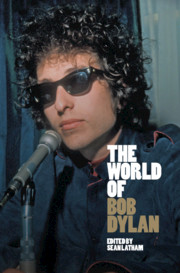Book contents
- The World of Bob Dylan
- The World of Bob Dylan
- Copyright page
- Contents
- Contributors
- Acknowledgments
- Introduction: Time to Say Goodbye Again
- Part I Creative Life
- Part II Musical Contexts
- Chapter 5 Folk Music
- Chapter 6 The Blues: “Kill Everybody Ever Done Me Wrong”
- Chapter 7 Gospel Music
- Chapter 8 Country Music: Dylan, Cash, and the Projection of Authenticity
- Chapter 9 Rock Music
- Chapter 10 Roots Music: Born in a Basement
- Chapter 11 The Great American Songbook
- Part III Cultural Contexts
- Part IV Political Contexts
- Part V Reception and Legacy
- Further Reading
- Index
Chapter 8 - Country Music: Dylan, Cash, and the Projection of Authenticity
from Part II - Musical Contexts
Published online by Cambridge University Press: 21 April 2021
- The World of Bob Dylan
- The World of Bob Dylan
- Copyright page
- Contents
- Contributors
- Acknowledgments
- Introduction: Time to Say Goodbye Again
- Part I Creative Life
- Part II Musical Contexts
- Chapter 5 Folk Music
- Chapter 6 The Blues: “Kill Everybody Ever Done Me Wrong”
- Chapter 7 Gospel Music
- Chapter 8 Country Music: Dylan, Cash, and the Projection of Authenticity
- Chapter 9 Rock Music
- Chapter 10 Roots Music: Born in a Basement
- Chapter 11 The Great American Songbook
- Part III Cultural Contexts
- Part IV Political Contexts
- Part V Reception and Legacy
- Further Reading
- Index
Summary
Dylan’s explicit foray into country music in his recordings in the late 1960s evolved out of his earlier interest in the genre, which he grew up listening to in childhood. He has described country artists such as Hank Williams and Johnny Cash as childhood heroes; cited the Carter Family as an early influence; and recorded three albums in Nashville – Blonde on Blonde (1966), John Wesley Harding (1967), and Nashville Skyline (1969) – using some of the city’s famed session musicians.1 Of those albums, two are most relevant to Dylan’s interest in country as a genre: John Wesley Harding was Dylan’s more pared down genre mix of folk and rock inflected by country that drew on American roots music and shared similarities with Cash’s signature sound with the Tennessee Three, while Nashville Skyline was an explicitly mainstream country album. The latter especially is often cited as a pioneering work in country-rock that influenced other musicians and sparked a boom in that hybrid genre. Dylan has continued to incorporate country into his oeuvre over his career, in some of his own country-inflected compositions and, notably, in tribute songs for Williams, Cash, the Stanley Brothers, and Jimmie Rodgers. In his live performances, he has included country instrumentation on his tour since the late 1990s, including banjo, fiddle, mandolin, and pedal steel guitar, and he has also toured with Willie Nelson (2004).
- Type
- Chapter
- Information
- The World of Bob Dylan , pp. 100 - 111Publisher: Cambridge University PressPrint publication year: 2021

